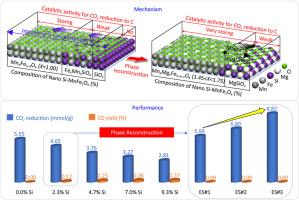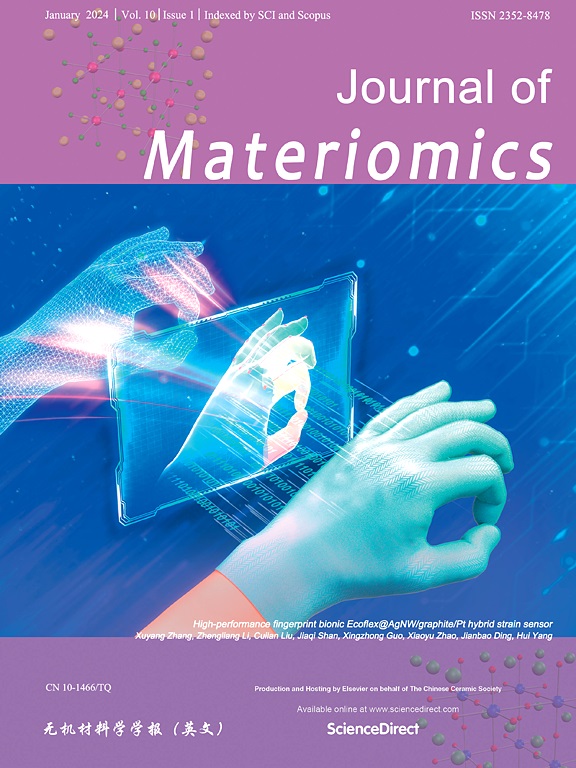Enhancing catalytic CO2 reduction to carbon performance of nano-MnFe2O4 prepared from high-silica manganese ores via MgO phase reconstruction strategy
IF 9.6
1区 材料科学
Q1 CHEMISTRY, PHYSICAL
引用次数: 0
Abstract
Silicon (Si) has been proven to significantly enhance CO2 reduction efficiency of numerous catalysts. However, the lack of research on Si's effect on manganese ferrite catalytic performance presents a challenge in using high-silica manganese ore to prepare cost-effective, efficient manganese-based ferrite decarbonization catalysts. This work prepared Nano-MnFe2O4 materials containing 0.0%–9.3%Si (2.3% increments, mass fraction) by solid-phase synthesis (1300 °C, air) and nano-grinding. The effect, mechanism, and enhancement strategy of Si on the low-temperature catalytic reduction of CO2 to carbon (C) performance of Nano-MnFe2O4 were systematically investigated. Results showed that introducing Si transformed Nano-MnFe2O4 into Nano-MnXFe3–XO4 (0.75 < X < 1.00) with degraded catalysis and Nano-FeYMnZSiO4 with almost no activity, lowering CO2 reduction to C from 5.55 mmol/g to 2.81 mmol/g. Increasing Si concentration simultaneously decreased the content and X-value of Nano-MnXFe3-XO4, causing fewer oxygen vacancies and declined CO2 reduction. A phase reconstruction strategy to eliminate Si impact and enhance catalysis was proposed, i.e., adding MgO, increasing Mn/Fe ratio, and nano-grinding followed by magnetic separation. Nano-Mg0.19Mn1.70Fe1.11O4 reconstructed from Nano-MnFe2O4 with 2.3% Si exhibited 8.82 mmol/g CO2 reduction and 100% carbon conversion at 350 °C. Mg2+ doping strengthened the conversion of Mn2+ to highly catalytically active Mn3+ and Mn4+ ions, increasing oxygen vacancies and electron transport for C=O rupture.


通过MgO相重构策略提高高硅锰矿石制备的纳米mnfe2o4的催化CO2还原碳性能
硅(Si)已被证明能显著提高多种催化剂的CO2还原效率。然而,缺乏对硅对锰铁氧体催化性能影响的研究,这给利用高硅锰矿石制备经济高效的锰基铁氧体脱碳催化剂带来了挑战。本文采用固相合成(1300℃,空气)和纳米研磨法制备了si含量为0.0% ~ 9.3%(质量分数为2.3%)的纳米mnfe2o4材料。系统研究了Si对纳米mnfe2o4低温催化还原CO2到碳(C)性能的影响、机理和增强策略。结果表明,Si的引入将纳米mnfe2o4转化为纳米mnxfe3 - xo4 (0.75 <;X & lt;纳米feymnzsio4几乎没有活性,将CO2还原到C的速率从5.55 mmol/g降低到2.81 mmol/g。增加Si浓度同时降低了纳米mnxfe3 - xo4的含量和x值,导致氧空位减少,CO2还原率下降。提出了一种相重构策略,即添加MgO,提高Mn/Fe比,纳米磨矿后进行磁选,以消除Si的影响,增强催化剂的催化作用。在350℃下,由Si含量为2.3%的纳米mnfe2o4重建的纳米mg0.19 mn1.70 fe1.11o4的CO2还原率为8.82 mmol/g,碳转化率为100%。Mg2+的掺杂增强了Mn2+向高催化活性Mn3+和Mn4+离子的转化,增加了氧空位和C=O断裂的电子传递。
本文章由计算机程序翻译,如有差异,请以英文原文为准。
求助全文
约1分钟内获得全文
求助全文
来源期刊

Journal of Materiomics
Materials Science-Metals and Alloys
CiteScore
14.30
自引率
6.40%
发文量
331
审稿时长
37 days
期刊介绍:
The Journal of Materiomics is a peer-reviewed open-access journal that aims to serve as a forum for the continuous dissemination of research within the field of materials science. It particularly emphasizes systematic studies on the relationships between composition, processing, structure, property, and performance of advanced materials. The journal is supported by the Chinese Ceramic Society and is indexed in SCIE and Scopus. It is commonly referred to as J Materiomics.
 求助内容:
求助内容: 应助结果提醒方式:
应助结果提醒方式:


